There are 17 types of turtles in Arkansas including different species like mud turtles, map turtles, painted turtles, snapping turtles, softshell turtles and even box turtles.
Arkansas is the 29th largest state within the United States of America and it hosts a humid climate with dense forest land.
The seventeen turtle species are residents within Arkansas namely:
- Common Map Turtle
- Common Snapping Turtle
- Alligator Snapping Turtle
- Common Musk Turtle
- Mississippi Map Turtle
- Missouri River Cooter
- Mississippi Mud Turtle
- Ornate Box Turtle
- Midland Smooth Shell
- Ouachita Map Turtle
- Red-eared Slider
- Southern Painted Turtle
- Three-toed Box Turtle
- Pallid Spiny Softshell
- Razorback Musk Turtle
- Western Spiny Softshell
- Western Chicken Turtle
Each of these turtle species have unique attributes that separate them from each other. One of the most important things to pay attention to is their conservation level – as the rise in popularity in having pet turtles has led to some species being over-caught.
Types Of Turtles In Arkansas
1. Common Map Turtle
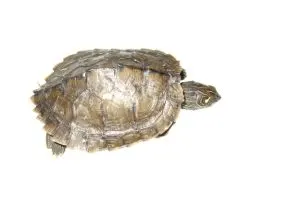
Quick Facts
- Experience level: Beginner
- Family: Emydidae
- Scientific Name: Graptemys geographica
- Common Name: Common Map Turtle
- Average Adult Size: 3 – 10 inches
- Life Span: 30-50 years
- Average Price Range: Approximately $50
- Conservation Status: Least Concern
The Common Map Turtle gets its name from the appearance of its shell as it has a map-like pattern on it. They are typically darker in colour ranging from a darker brown to black, but the map-like pattern is lighter in colour.
As with most turtle species, the females are usually bigger than the males. They are mainly found in freshwater such as rivers, lakes and large streams. The Common Map Turtles prefer large bodies of water.
Their diet consists of both vegetation and aquatic insects and animals.
2. Common Snapping Turtle
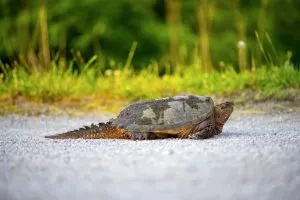
Quick Facts
- Experience level: Intermediate
- Family: Chelydridae
- Scientific Name: Chelydra Serpentina
- Common Name: Snapping Turtle
- Average Adult Size: 12-15 inches, rarely they can get as big as 19 inches
- Life Span: 30 – 50 years
- Average Price Range: Approximately $25-60
- Conservation Status: Least concern
The Common Snapping Turtle has a strong beak-like jaw and a flexible neck, and paired with their aggressive temperament they can be a difficult turtle to handle.
They arent the only aggressive turtle out there though.
They can be found in any fresh body of water with a muddy bottom, and hunt aquatic animals and insects within the water. They also eat vegetation and fruits. Their diets are omnivorous.
Their colouring ranges from brown to black. They have long necks, tails and legs.
3. Alligator Snapping Turtle
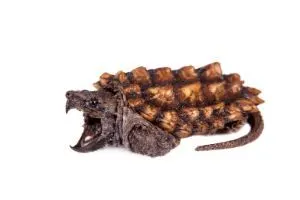
Quick Facts
- Experience level: Intermediate – expert
- Family: Chelydridae
- Scientific Name: Macrochelys temminckii
- Common Name: Alligator Snapping Turtle
- Average Adult Size: 15 – 26 inches
- Life Span: 60 – 70 years
- Average Price Range: Approximately $100 – 150
- Conservation Status: Vulnerable
The Alligator Snapping Turtle has a jaw so powerful that their bite can break through bone.
This coupled with their size makes them an intimidating turtle, they resemble dinosaurs. Despite this, their temperament is not very aggressive.
They are usually found at the bottom of bodies of water such as lakes, swamps and rivers. They lie motionless within the water with their mouths open and wait for fish to swim into their mouths.
They rarely leave the water, the females will however leave to go nest. They can reach incredible sizes, and get up to 150 pounds, and need to be kept outdoors.
4. Common Musk Turtle
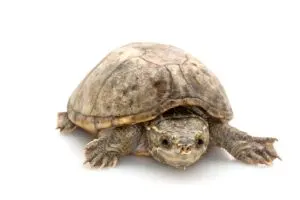
Quick Facts
- Experience level: Intermediate
- Family: Kinosternidae
- Scientific Name: Sternotherus odoratus
- Common Name: Common Musk Turtle
- Average Adult Size: 2 – 5 inches
- Life Span: 30-50 years
- Average Price Range: Approximately $50
- Conservation Status: Least Concern
The common musk turtle are some of the smaller turtles and are distinguished by two light coloured stripes on their head, and a ridge along the length of their shell. The Common Musk Turtle is darker in colour and range between brown and black.
They can be found in slow moving fresh water bodies, and prefer bodies of water that have a soft, muddy bottom.
They release a musky smell to scare off their predators, and they have been known to bite and scratch in self defense. They spend the majority of their time in water.
5. Mississippi Map Turtle
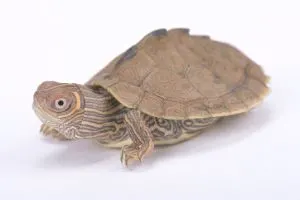
Quick Facts
- Experience level: Intermediate – expert
- Family: Emydidae
- Scientific Name: Graptemys pseudogeographica kohni
- Common Name: Mississippi Map Turtle
- Average Adult Size: 3 – 10 inches
- Life Span: 30 – 50 years
- Average Price Range: Approximately $30
- Conservation Status: Least Concern
These turtles are shy, but do spend more time out of the water as opposed to other native turtle species. The map-like pattern on their back fades as they age, and they are mainly olive, brown or black in colour. Their skin is covered in yellow stripes.
They have strong jaws and have a nasty bite. Their diet consists of both vegetation and aquatic animals and insects. They typically eat river crustaceans and snails.
The Mississippi Map Turtle prefers strong currents and deep waters. They spend the majority of their lives submerged in water. They are most active in climates of above 85 degrees fahrenheit.
6. Missouri River Cooter
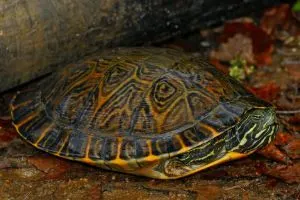
Quick facts
- Experience level: Beginner
- Family: Emydidae
- Scientific Name: Pseudemys Concinna Metteri
- Common Name: Missouri River Cooter
- Average Adult Size: 8 – 15 inches
- Life Span: 20 – 40 years
- Average Price Range: Approximately $40
- Conservation Status: Least Concern
The Missouri River Cooter is a subspecies of the river cooter and is an omnivorous turtle but they prefer to eat vegetation and fruits. They have been seen eating snails and other aquatic animals.
Their shells are similar to other native species and vary between olive green, brown and black. They have yellow lines that feature down their heads and limbs. There are also yellow lines along their shells, with faint grey markings.
Typically they can be found water streams but can also make ponds and lakes their home.
Females are larger than males, whereas males have flatter shells.
7. Mississippi Mud Turtle
Quick facts
- Experience level: Intermediate
- Family: Kinosternidae
- Scientific Name: Kinosternon subrubrum hippocrepis
- Common Name: Mississippi Mud Turtle
- Average Adult Size: 5 – 7 inches
- Life Span: 30 – 50 years
- Average Price Range: Approximately $40
- Conservation Status: Least Concern
The Mississippi Mud Turtle is a smaller species, and spends extended amounts of time in bodies of water. They sometimes grow algae on their shells, but are mainly dull in colour. Their shells are dome shaped.
They have hints of yellow across their bodies. Their back feet are webbed while their front feet aren’t. Unlike other species, the males are larger than females.
As their name indicates, they prefer bodies of water with soft, muddy bottoms. They are most commonly found in slow-moving bodies of water such as ponds, and lakes. The Mississippi Mud Turtle is omnivorous, and they survive off of both vegetation and fish, insects and fruits.
8. Ornate Box Turtle
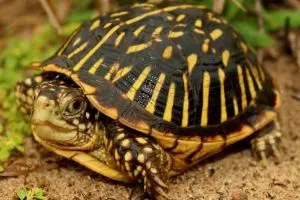
Quick facts
- Experience level: Intermediate
- Family: Emydidae
- Scientific Name: Terrapene ornata ornata
- Common Name: Ornate Box Turtle
- Average Adult Size: 5-7 inches
- Life Span: 40 – 60 years
- Average Price Range: Approximately $30 – 100
- Conservation Status: Near Threatened
The little Ornate Box Turtle is a threatened species as they have been overcaught and their habitats have been destroyed over the years. In order to protect themselves, they draw their head and limbs into their shells, which resembles a box.
They eat anything they can find and eat an omnivorous diet. They feed off of vegetation, fruits, and insects.
Their shells are more vivid in patterns compared to other species. They range in colour from browns to black, and have yellow and orange markings across their shells and body.
9. Midland Smooth Shell
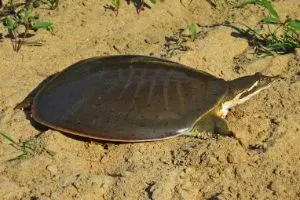
Quick facts
- Experience level: Intermediate
- Family: Trionychidae
- Scientific Name: Apalone mutica
- Common Name: Midland Smooth Shell
- Average Adult Size: 6 – 13 inches
- Life Span: 40 – 60 years
- Average Price Range: Approximately $50
- Conservation Status: Least Concern
These turtles have a soft shell instead of a hard one, which makes them more vulnerable to attack. They are however faster on land and in the water than other species of turtles.
They eat an omnivorous diet but prefer meat over vegetation, and will mainly eat fish, insects, and snails. They will also eat fruits and other vegetations.
Their bodies are flatter in shape, and range from olive to grey or brown in colour. Their head and limbs are lighter in colour. Their eyes are a stark yellow framed by a black eye. They usually have a yellow stripe behind their eyes as well.
10. Ouachita Map Turtle
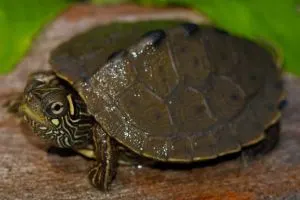
Quick facts
- Experience level: Beginner
- Family: Emydidae
- Scientific Name: Graptemys ouachitensis
- Common Name: Ouachita Map Turtle
- Average Adult Size: 3 – 10 inches
- Life Span: 30 – 50 years
- Average Price Range: Approximately $40 – 100
- Conservation Status: Least Concern
The Ouachita Map Turtle is a subspecies of the Map Turtle, and is mainly found in slow moving bodies of water where there is lots of vegetation. They live in lakes, ponds, streams and rivers.
Map turtles can be difficult to tell apart as their appearances are similar, the Ouachita Map Turtle ranges from olive greens to brown or black. As they age, the map pattern on their shell fades. They are distinguished by a vertebral keel.
They eat anything they can find and as such are omnivorous. They will eat aquatic vegetation, fruits, insects, fish and other meat.
11. Red-eared Slider
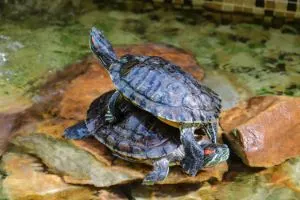
Quick facts
- Experience level: Beginner
- Family: Emydidae
- Scientific Name: Trachemys scripta elegans
- Common Name: Red-eared Slider
- Average Adult Size: 7 – 12 inches
- Life Span: 30 – 40 years
- Average Price Range: Approximately $20
- Conservation Status: Least Concern
The Red-eared Slider Turtle has red stripes that run behind their eyes along their heads, these stripes can also vary slightly to an orange or yellow colour. Their shell and skin range from browns to blacks.
Their diet is omnivorous, and they eat insects, snails, sometimes fish and other aquatic vegetation and fruits. They mainly live in slow moving bodies of water such as lakes, creeks, marshes and ponds.
The females generally get bigger than the males.
12. Southern Painted Turtle
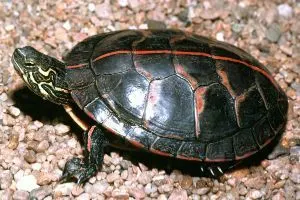
Quick facts
- Experience level: Beginner
- Family: Emydidae
- Scientific Name: Chrysemys picta
- Common Name: Southern Painted Turtle
- Average Adult Size: 5 – 7 inches
- Life Span: 20 – 30 years
- Average Price Range: Approximately $100
- Conservation Status: Least Concern
The Southern Painted Turtle looks as though its shell has been painted with yellow, red or orange stripes. Their shells and bodies are brown to blackish in colour and their heads have yellow stripes running along it.
They are the smallest subspecies within the Painted Turtle family. They prefer to live in freshwater and are typically found in lakes, ponds and rivers.
Their diet is omnivorous and they will eat insects, fish and vegetation.
13. Three-toed Box Turtle
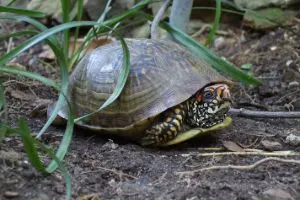
Quick facts
- Experience level: Intermediate
- Family: Emydidae
- Scientific Name: Terrapene carolina triunguis
- Common Name: Three-toed Box Turtle
- Average Adult Size: 5 – 7 inches
- Life Span: 50 – 100 years
- Average Price Range: Approximately $150
- Conservation Status: Vulnerable
The Three-toed Box Turtle is a small species that prefers to live on land rather than water, unlike most turtle species that are aquatic.
They range from olive to grey in colour, and their shell is distinguished into two colours – the top is typically lighter in colour. They eat anything they can find and will eat insects, fruits and other vegetation and meat.
14. Pallid Spiny Softshell

Quick facts
- Experience level: Intermediate
- Family: Trionychidae
- Scientific Name: Apalone spinifera pallida
- Common Name: Pallid Spiny Softshell
- Average Adult Size: 5 – 20 inches
- Life Span: 40 – 60 years
- Average Price Range: Approximately $50
- Conservation Status: Least Concern
The Pallid Spiny Softshell turtle is unique in that its shell is soft instead of hard like many other turtles. The males are usually half the size of females. Males typically get to 5-10 inches, whereas females get to 9-20 inches.
They spend extended periods in water and are typically found in lakes, ponds, rivers and marshes. They mainly eat small animals, aquatic snails and insects.
They are flat and have a snout-like nose, and are an olive, grey or brownish colour.
15. Razorback Musk Turtle

Quick facts
- Experience level: Beginner
- Family: Kinosternidae
- Scientific Name: Sternotherus carinatus
- Common Name: Razorback Musk Turtle
- Average Adult Size: 5 – 6 inches
- Life Span: 40 – 50 years
- Average Price Range: Approximately $50 – 150
- Conservation Status: Least Concern
The Razorback Musk Turtle is mostly found in bodies of water, they rarely leave the water but its not uncommon to see them walking at the bottom of the aquarium if they are captive or at the bottom of a body of water.
Their shells range between olive, grey, brown or black and sometimes are a variation of these. Their skin can appear to be spotted and on average is olive to dark brown in colour.
They are carnivorous and eat predominantly snails, aquatic insects, mollusks and fish.
16. Western Spiny Softshell
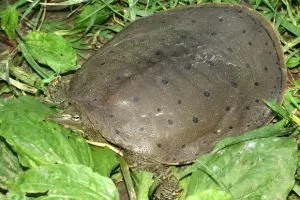
Quick facts
- Experience level: Intermediate
- Family: Trionychidae
- Scientific Name: Apalone spinifera hartwegi
- Common Name: Western Spiny Softshell
- Average Adult Size: 5 – 20 inches
- Life Span: 40 – 60 years
- Average Price Range: Approximately $50
- Conservation Status: Least Concern
Male Western Spiny Softshell are significantly smaller than female Western Spiny Softshells. The males range between 5 – 10 inches, and females can get to between 9-20 inches.
They are flat and have a snout-like nose. Their shells are soft. They vary between light to dark browns, and have slight olive colouring.
Their habitats are mainly in bodies of water such as lakes, ponds and rivers. Western Spiny Softshell turtles are carnivorous and eat snails, insects and small aquatic animals.
17. Western Chicken Turtle
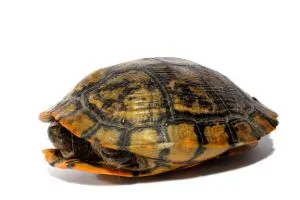
Quick facts
- Experience level: Beginner
- Family: Emydidae
- Scientific Name: Deirochelys reticularia miaria
- Common Name: Western Chicken Turtle
- Average Adult Size: 5 – 10 inches
- Life Span: 15 – 30 years
- Average Price Range: Approximately $140
- Conservation Status: Least Concern
The Western Chicken Turtle is a freshwater turtle and can be found in most slow moving or still water such as lakes, ponds, marshes, ponds or sandhills.
Their diet consists of fruits, vegetation and other meat such as fish, insects and snails. They will also eat fruit. Ultimately they are carnivorous.
They have an oval shape, and are olive to dark brown in colour. The top of their shell has a faint pattern on, and their skin is covered in yellow stripes.
Conclusion
Arkansas is home to 17 species of turtles who each have their own unique attributes. The climate makes it the perfect home for turtles, and these are only the native species home to Arkansas.
Other nearby states
- Turtles in Kansas
- Turtles in Louisianna
- Turtles in Mississippi
- Turtles in Missouri
- Turtles in Oklahoma
- Turtles in Tennessee
- Turtles in Texas

Aurora Najera
Thursday 7th of October 2021
I have a box turtle with orange on head and next, how can you tell the sex?
Sharon Gannaway
Sunday 15th of August 2021
Too bad the paragraphs aren't showing up in the preview of my comment as it awaits moderation. It's going to be difficult to read. Sharon
Brock Yates
Monday 16th of August 2021
@Sharon, Could you please clarify what the issue you are having is?
Lois Brabston
Friday 28th of May 2021
We found a fairly large turtle in Arkansas. Sort of flattish back. Covered in mud. Jagged back shell. Very long claws. Any ideas?
Brock Yates
Saturday 29th of May 2021
Send us an email [email protected] with a couple of good pics. Tough to say from the description, but sounds possibly like a common snapping turtle or aligator snapping turtle.